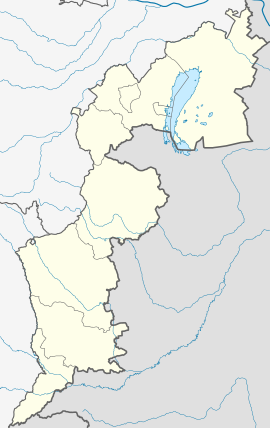Siegendorf
show This article may be expanded with text translated from the corresponding article in Hungarian. (December 2009) Click [show] for important translation instructions. |
show This article may be expanded with text translated from the corresponding article in German. (December 2009) Click [show] for important translation instructions. |
Siegendorf | |
|---|---|
 Municipal office | |
 Coat of arms | |
 Siegendorf Location within Austria | |
| Coordinates: 47°47′N 16°32′E / 47.783°N 16.533°ECoordinates: 47°47′N 16°32′E / 47.783°N 16.533°E | |
| Country | |
| State | Burgenland |
| District | Eisenstadt-Umgebung |
| Government | |
| • Mayor | Rainer Porics (SPÖ) |
| Area | |
| • Total | 23.06 km2 (8.90 sq mi) |
| Elevation | 176 m (577 ft) |
| Population (2018-01-01)[2] | |
| • Total | 2,963 |
| • Density | 130/km2 (330/sq mi) |
| Time zone | UTC+1 (CET) |
| • Summer (DST) | UTC+2 (CEST) |
| Postal code | 7011 |
| Website | www.siegendorf.at |
Siegendorf (Croatian: Cindrof, Hungarian: Cinfalva) is a town in the district of Eisenstadt-Umgebung in the Austrian state of Burgenland.
History[]
During World War II, a forced labor camp staffed by Hungarian Arrow Cross guards forced Jewish men from northern Transylvania located in Hungarian-occupied Romania, was located in Siegendorf. Nearly all of the inmates were executed by the Hungarian guards as the Soviet liberation forces were approaching when the guards pretended to want to march the Jewish inmates to an unknown location. Very few prisoners survived. Almost none of them documented their experience at this camp except one former inmate who incorrectly claims to be the "sole" survivor. Bear in mind, many survivors were not articulate and did not care to memorialize this experience in writing. But they have passed their experience along via their children and/or grandchildren. The Jewish slaves at the Siegendorf Camp were enslaved in a local gold mine.
Population[]
| Year | Pop. | ±% |
|---|---|---|
| 1869 | 1,585 | — |
| 1880 | 1,589 | +0.3% |
| 1890 | 1,591 | +0.1% |
| 1900 | 1,886 | +18.5% |
| 1910 | 1,938 | +2.8% |
| 1923 | 2,077 | +7.2% |
| 1934 | 2,363 | +13.8% |
| 1939 | 2,247 | −4.9% |
| 1951 | 2,387 | +6.2% |
| 1961 | 2,400 | +0.5% |
| 1971 | 2,454 | +2.2% |
| 1981 | 2,402 | −2.1% |
| 1991 | 2,446 | +1.8% |
| 2001 | 2,720 | +11.2% |
| 2011 | 2,902 | +6.7% |
References[]
- ^ "Dauersiedlungsraum der Gemeinden Politischen Bezirke und Bundesländer - Gebietsstand 1.1.2018". Statistics Austria. Retrieved 10 March 2019.
- ^ "Einwohnerzahl 1.1.2018 nach Gemeinden mit Status, Gebietsstand 1.1.2018". Statistics Austria. Retrieved 9 March 2019.
- Cities and towns in Eisenstadt-Umgebung District
- Nazi concentration camps in Austria
- Jewish Austrian history
- Jewish Hungarian history
- Holocaust locations in Austria
- Burgenland geography stubs
- Hungarian history stubs
- Austrian history stubs

